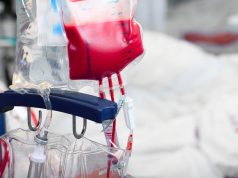Greater increase in mean hemoglobin at 12 weeks versus iron polysaccharide complex
WEDNESDAY, June 14, 2017 (HealthDay News) — For children with nutritional iron-deficiency anemia (IDA), ferrous sulfate is associated with a greater increase in hemoglobin concentration at 12 weeks compared with iron polysaccharide complex, according to a study published in the June 13 issue of the Journal of the American Medical Association.
Jacquelin M. Powers, M.D., from the Baylor College of Medicine in Houston, and colleagues randomized 80 infants aged 9 to 48 months with nutritional IDA to 3 mg/kg of elemental iron once daily as ferrous sulfate drops or iron polysaccharide complex drops for 12 weeks (28 and 31, respectively, completed the trial).
The researchers found that the mean hemoglobin increased from 7.9 to 11.9 g/dL in the ferrous sulfate group, compared with 7.7 to 11.1 g/dL in the iron polysaccharide complex group (greater difference of 1.0 g/dL with ferrous sulfate). The ferrous sulfate group had a higher proportion of patients with complete resolution of IDA (29 versus 6 percent). Over 12 weeks there was an increase in median serum ferritin level, from 3.0 to 15.6 ng/mL in the ferrous sulfate group and from 2.0 to 7.5 ng/mL in the iron complex group (greater difference of 10.2 ng/mL). There was a greater decrease in mean total iron-binding capacity with ferrous sulfate (greater difference of −50 µg/dL).
“Once daily, low-dose ferrous sulfate should be considered for children with nutritional iron-deficiency anemia,” the authors write.
The study was an investigator-initiated trial with sponsorship from Gensavis Pharmaceuticals, the manufacturer of the iron polysaccharide complex used in the trial; Gensavis provided funding for both trial drugs.
Copyright © 2017 HealthDay. All rights reserved.








